Increased dentin sensitivity
Machine translation
Original article is written in RU language (link to read it) .
Increased dentin sensitivity is a problem that a patient has come to you with. And it needs to be resolved quickly! First of all, teach the patient to brush their teeth properly: it seems funny, but many patients don't know how to do this! They apply too much pressure on the brush and often injure the gum.
About the prevention of tooth sensitivity after home whitening at the webinar Overview of teeth whitening techniques: laser whitening, light whitening, home and office whitening.
Then alleviate the pain in a simple, quick, and effective way: by applying fluoride varnish. Recommend using a desensitizing toothpaste, which can be used not only for brushing teeth but also for "emergency" relief of increased dentin sensitivity symptoms. The paste is applied with a finger to the painful areas. It's easy, inexpensive, quick, and effective! You will surely increase patients' confidence in themselves and their trust in you, making it easier to manage your patients throughout the treatment.
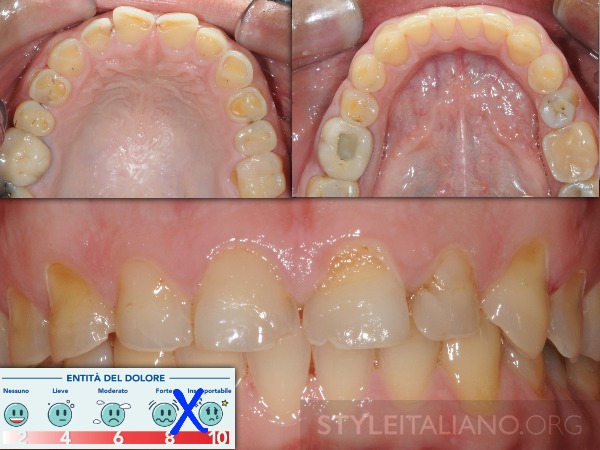
Photo 1
Clinical Examples
Let's consider some clinical cases.
A 45-year-old man complains of increased dentin sensitivity (9 points on a visual-analog scale of pain). He has pronounced bruxism, gastroesophageal reflux disease, and poor oral hygiene. First of all, it is necessary to eliminate the increased dentin sensitivity in order to painlessly perform professional hygiene and develop a restoration treatment plan.
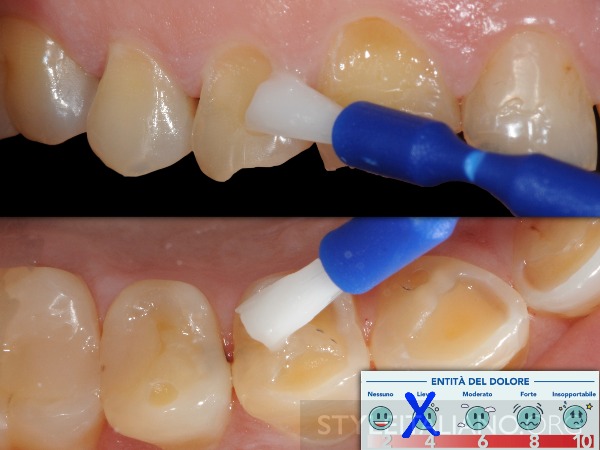
Photo 2
Fluoride varnish was applied, and the correct technique for cleaning with a desensitizing toothpaste was demonstrated. At the follow-up visit after 7 days, the patient felt much more confident and calm in the dental chair (4 points on the visual-analog scale of pain).
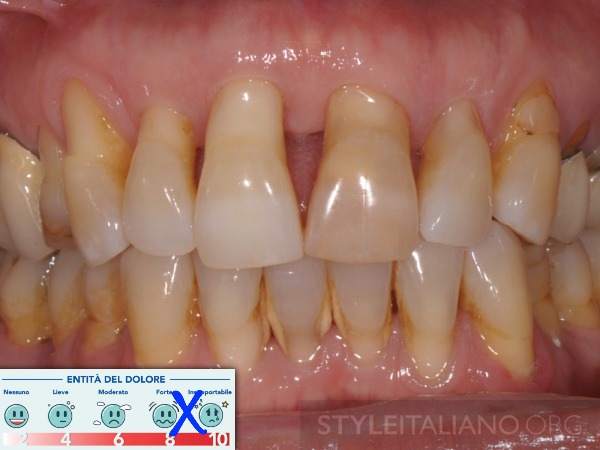
Photo 3
A 55-year-old woman is concerned about the aesthetics of her smile, tooth mobility, and increased dentin sensitivity (9 on the visual-analog pain scale). Due to increased sensitivity, she developed a fear of visiting the dentist.
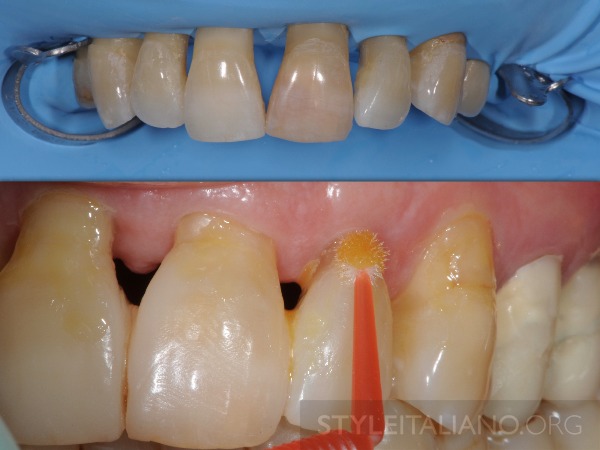
Photo 4
During the first visit, teeth from 1.3 to 2.3 were immobilized with composite, diastemas were reduced, and then fluoride varnish was applied to each recession area. The goal of the treatment was to stabilize the teeth, make a slight aesthetic improvement, and eliminate increased sensitivity.
A proper brushing technique was demonstrated, and it was recommended to gently massage the sensitive areas with a desensitizing toothpaste.
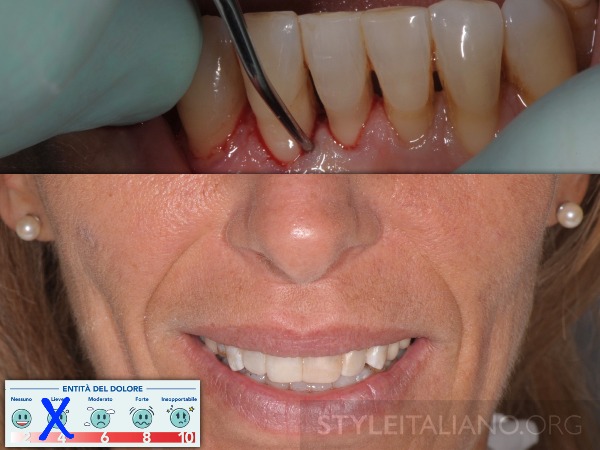
Photo 5
The sensitivity of the dentin decreased (4 on the visual-analog scale), the patient stopped fearing the dentist, and was motivated for comprehensive periodontal treatment.

Photo 6
A 31-year-old woman came for a consultation complaining of increased dentin sensitivity (8 on a visual-analogue scale): she experienced pain when drinking room temperature water and even when breathing.
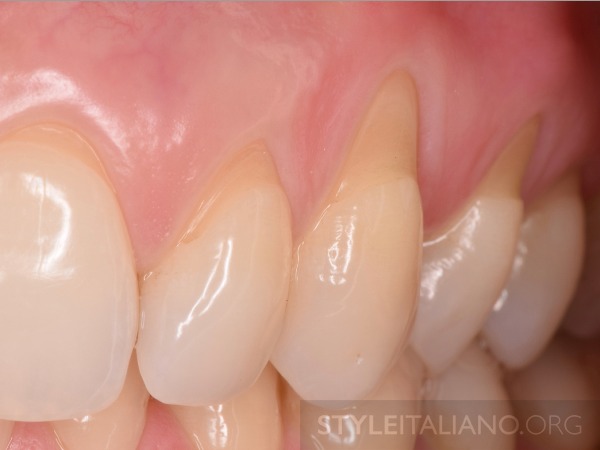
Photo 7
During the clinical examination, gum recession and tooth wear were detected. Much time was spent educating the patient on the proper way to brush teeth with low pressure and without harming the gums.
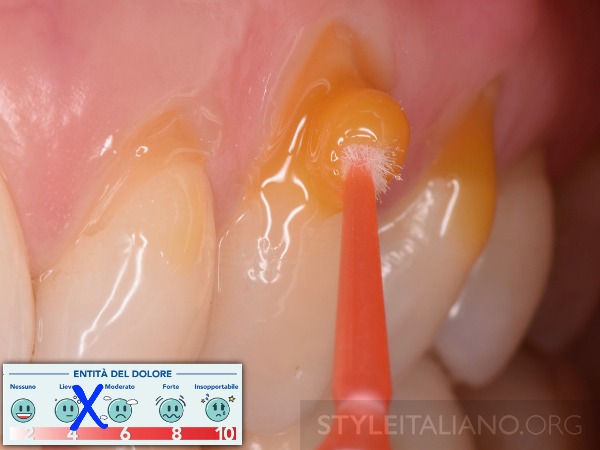
Photo 8
Then, fluoride varnish was applied and after a week the dentin sensitivity test was repeated (5 on the scale).
Follow-up visit
Talk to the patient and listen to them! Ask about changes in symptoms (frequency, intensity, duration). Retest and compare the results. If the result is unsatisfactory, refine the diagnosis and try a different treatment strategy. If the result is good, conduct maintenance therapy.
After covering the teeth with fluoride varnish and using desensitizing toothpaste, talk to the patient again, repeat the tests, and compare the results. If the result is unsatisfactory, refine the diagnosis or choose another treatment plan.
- Air flow test after treatment of increased dentin sensitivity.
- Tactile test after treatment of increased dentin sensitivity.
- Cold water test after treatment of increased dentin sensitivity.
- Interview after treatment of increased dentin sensitivity.
Identify the etiology and predisposing factors: tooth wear, erosion, dietary features. Try to eliminate these factors or reduce their impact. Treatment with current methods and means (pastes, varnishes) is the method of choice.
Try not to cause the patient pain with harmless procedures: irrigation with cold water and drying. Patients with increased dentin sensitivity are wary of dental manipulations, as they experience pain even from stimuli of normal intensity.
Reducing Dentin Sensitivity
It is important to pay attention to increased dentin sensitivity, because it is a serious problem for many patients. Therapy aimed at reducing sensitivity can help eliminate side effects during various types of dental interventions.
About methods of preventing postoperative tooth sensitivity in the webinar Strategies for Improving Direct Composite Restoration.
Literature
Cummins D. J Clin Dent. 2009; 20 (spec iss): 1–9. Zapera. YouGov, 2009.
Brannstrom M, Astrom A. Int Dent J. 1972; 22: 219-27.
Canadian Advisory Board on Dentin Hypersensitivity. J Can Dent Assoc. 2003; 69: 221-6.
Susin C, Haas AN, Oppermann RV, Haugejorden O, Albandar JM. J Periodontol. 2004; 75: 1377–1386
Von Troil B, Needlemen I, Sanz M. J Clin Periodontol. 2002; 29 (supplement 3) :173-7.
Addy M. Int J Dent . 2002; 52: 367 – 375.
Van Haywood B. Inter Dent J. 2002; 52: 7–10.
Dowell P, Addy M. J Clin Periodontol. 1983; 4: 341-50.
Kleinberg I. Dent Today 2002; 21: 42-7.
Chesters R. J Clin Periodontol. 1992; 19: 256–261.
Vasconcelos A. Acta Odontologica Scandinavica. 2012; 70: 337–34.
NathooS J. Clin Dent 2009, 20 special issue: 123-130
Ayad F et al. J Clin Dent 2009. 20 special issue: 10-16
http://styleitaliano.org/
